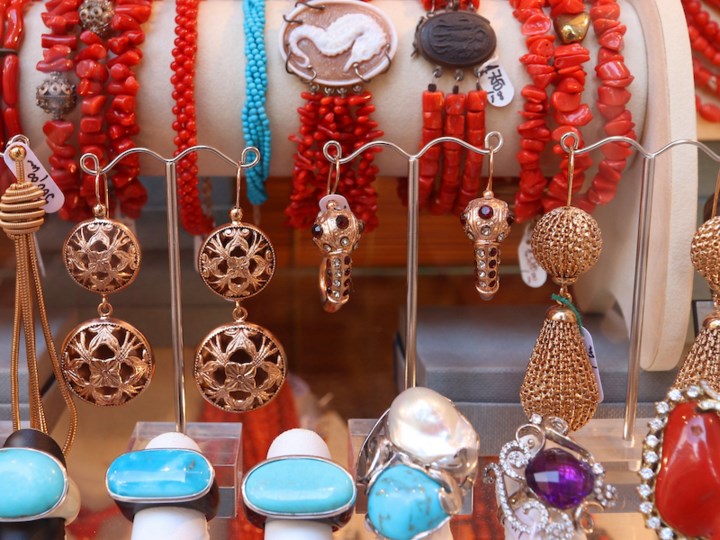Traces of Croatia's rich history and traditions can be found in numerous cultural sights, gastronomy, but also in
traditional jewellery. Just as each region in Croatia differs in its culture, so does the jewellery which women wore as an
expression of their family and financial status. Today, this timeless jewellery is a fashionable detail worn by girls and women of all generations.
If you stay in one of
our beautiful villas with pool on the Adriatic coast, one of the
most beautiful souvenirs is certainly traditional jewellery. Traditional jewellery is mostly made of
gold or silver and you can find it in jewellery shops or souvenir shops. In this article, we will introduce you to
Croatia’s traditional jewellery and then it is up to you to choose the
ideal gift for you or your friends that will remind you of your trip to Croatia.
 Dalmatia
Dalmatia
Dalmatia is one of the most interesting regions in Croatia. It is fascinating how
dialects, traditions and lifestyles differ in such a small area. Dalmatia stretches from Dubrovnik in the south to Zadar and its islands. The
characteristic of this region is that its culture has had many influences that have shaped not only the
architecture, but also the
way of life. Fashion styles arrived in different ways,
from sailors to merchants. Jewellery was only worn on
special occasions in these areas as an
indicator of material status.
Jewellery from
Dubrovnik is not only jewellery, but also a
reminder of ancient times from history. The
goldsmith's craft is one of the oldest in the world and the art has been cherished since the 13th century from the time of the
Republic of Dubrovnik. At that time, Dubrovnik was the largest centre of goldsmithing in Europe and
rich noble families competed for the jewellery. The best known are the Dubrovnik
peruzini, the Konavle
verizice and the Konavle
wedding earrings. In the past, wealthy young men gave the jewellery to popular and irresistible women from Konavle as a way of
expressing their love. During the engagement, the man would give his fiancée small earrings, and on the eve of the wedding,
large earrings with pearls.

As in other parts of Dalmatia,
Venice had the greatest influence on the jewellery of the inhabitants of
Split. The jewellery was mostly made of gold and decorated with
pearls, corals and gemstones. Of the jewellery, the most famous were earrings called
kosarice, which were decorated with
pearls and coral. A speciality is also the needle called
tretamenat, which was used to decorate the women's
braided hairstyles. The needle consisted of several spirals decorated with gold granules or pearls, while the central needle had
the shape of a bird or a flower.
The
Sibenik button, or
Puca, adorned
men's traditional costumes throughout history. Today it is found in the form of
earrings, rings, pendants, tie pins, necklaces and more. The original button is made of silver, in a certain size. In addition to Sibenik buttons, there are also
florentines (in the shape of a flower), wings and rosettes. Sibenik rosettes are
traditional earrings inspired by the beautiful rosette found on the facade of the Sibenik Cathedral.
Not far from
Zadar is the
island of Pag, known for its first-class delicacies such as
Pag cheese and Pag lamb. Besides the gastronomic specialities, few people know about the long tradition of making lace and jewellery.
Pag necklaces and rocini, which dangled in the shape of little bells, play a significant role in jewellery making on the island of Pag. Such jewellery has been worn since the 16th century and today it can be seen as a
part of the traditional costume of Pag.
 Kvarner
Kvarner
A part of Croatian folk jewellery and a
symbol of the Kvarner, Rijeka and the Croatian coast is the
so-called Morcic. According to legend, the Morcic was created after an Italian countess gave her maid, who she loved very much, her
freedom. As a sign of her friendship, she ordered earrings with her face to be made as a souvenir. According to another legend, the Morcic was
made to commemorate the victory over the Ottomans on the
Grobnik field above Rijeka. Historically, it was worn by women, who used it to indicate that they
belonged to the Rijeka area, by sons, but also by sailors (one on the right ear) and fishermen as a kind of talisman to
protect them from storms. Today it is a symbol of good luck and earrings with its image are believed to bring optimism and
positive energy and protect against evil. People give it as a gift on special occasions such as weddings or the
birth of a child.
We believe you have already chosen your
favourite piece of jewellery and we are sure it will look perfect on you. Treat yourself with a beautiful souvenir that will forever remind you of the
unforgettable moments you spent in Croatia.
Ana-Marija Tot
31.5.2022

 MY ISTRIA GUIDE
MY ISTRIA GUIDE



